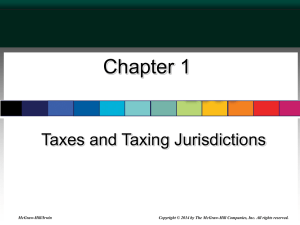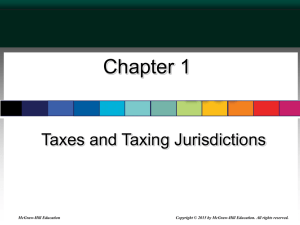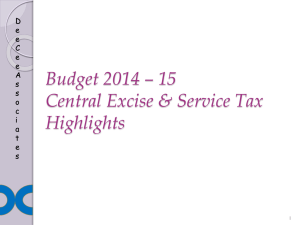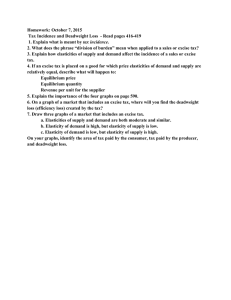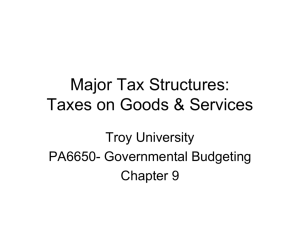April 16, 2015 - Gas Tax Overview
advertisement
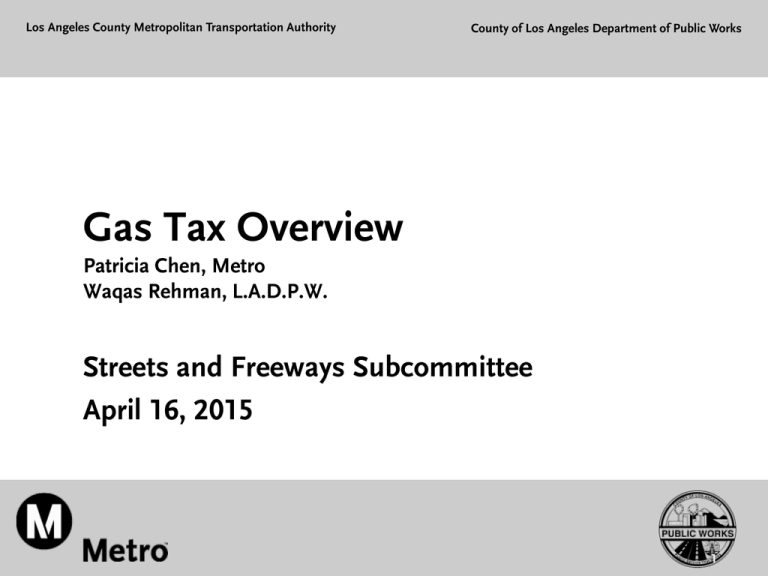
Los Angeles County Metropolitan Transportation Authority County of Los Angeles Department of Public Works Gas Tax Overview Patricia Chen, Metro Waqas Rehman, L.A.D.P.W. Streets and Freeways Subcommittee April 16, 2015 1 Agenda 1. 2. 3. 4. Introductions Gas Tax Background How the Gas Tax Works Drop in Gas Prices – Impact on Local Jurisdictions 5. Legislative Developments in Gas Tax 2 QUICK FACT 1 Approximately how many gallons of gasoline are sold annually in California? A. 80 Million B. 14 Billion C. 07 Billion D. 03 Billion 3 Correct Answer B. 14 Billion 4 QUICK FACT 2 What is the total amount of taxes LA County residents currently pay per gallon of gas? A. $1.67 B. $1.20 C. $0.67 D. $0.85 5 Correct Answer C. $0.67 6 Breakdown of Total Gas Tax in LA County FY 2014-15 Federal Excise Tax State Excise Tax State Sales Tax (2.25%) Local Sales Tax (1.5%) Underground Storage LA County Total Tax per gallon 7 $0.184 $0.360 $0.065 $0.045 $0.020 $0.674 How much do other countries pay? $6.00 Fuel Taxes by Country $5.00 Gasoline Diesel $ per Gallon $4.00 $3.00 $2.00 $1.00 $0.00 -$1.00 Source: http://www.afdc.energy.gov/data/10327 8 Fuel Taxes By Country Fuel Taxes by Country ($/gal) Mexico US Canada New Zlnd. Chile Australia Iceland Poland Japan Korea Estonia Spain Hungary Austria Luxembrg Czech Rep. Slovenia Switzerland Slovak Rep. Israel Sweden Ireland Italy Belgium Denmark Portugal France Greece Norway Finland UK Germany Netherlands Turkey Gasoline -$0.41 $0.49 $0.96 $1.20 $1.31 $1.34 $2.28 $2.40 $2.59 $2.64 $2.65 $2.66 $2.68 $2.77 $2.90 $3.04 $3.07 $3.09 $3.23 $3.23 $3.24 $3.41 $3.54 $3.58 $3.58 $3.65 $3.80 $3.82 $3.87 $3.93 $3.95 $4.10 $4.19 9 $5.52 Diesel -$0.28 $0.59 $0.77 $0.00 $0.44 $1.34 $2.03 $1.85 $1.55 $1.87 $2.46 $2.08 $2.17 $2.18 $1.94 $2.59 $2.03 $3.15 $2.31 $2.87 $2.56 $2.82 $2.65 $2.10 $2.68 $2.28 $2.69 $2.39 $2.97 $2.28 $3.95 $2.95 $2.29 $3.81 Distribution of State Gas Tax 1970 to 2016 10 State Gas Excise Tax Current rate is $0.36 per gallon until June 30, 2015. Beginning July 1, 2015 Rate will be $0.30 per gallon. • A base excise tax which has remained at 18c/gallon since 1994. • A price-based excise tax currently set at 18c/gallon, adjusted annually by BOE. 11 Priced Based State Excise Tax Distribution Annual Revenue - $0.18 x 14.5 billion gallons (average) = $2.6 Billion • The revenues received are first used to pay for monthly Transportation Bond Debt for a total of Approximately $1.0 Billion Annually • Remaining revenues distributed as follows: – 44% to STIP ($700 Million) – 12% to SHOPP ($195 Million) – 44% Local Subvention ($700 Million) as follows: • 50% to Cities statewide by population ($350 Million) • 50% to Counties statewide ($350 Million) – 75% based on Registered Vehicles – 25% based on Centerline Roadway Miles Maintained 12 Price-Based Excise Tax Distribution Comparison Source: Caltrans Budget and Allocation Capacity Update Presented to the California Transportation Commission, January 22, 2015 13 Gas Tax Legislation • Traffic Congestion Relief Act (2000) – Required gas sales tax revenue to be provided for the Traffic Congestion Relief Program (TCRP) from FY 04 to FY 08 • Proposition 42 (2002) – Amended State constitution to permanently require the transfer of gas sale tax revenues from the State General Fund to the Transportation Investment Fund (TIF) • Had been used for general purposes (education, health, social services, and corrections) – Required continuation of the use of gas sales tax for local and state transportation purposes beyond FY 04 to FY 08 – Allowed for suspension of the transfers in fiscal emergencies 14 Gas Tax Legislation cont. • Proposition 1A (2006) – Prompted by partial suspension of Prop 42 transfers in FY 2004 and full suspension in FY 2005 – Required repayment of revenue diverted from the TIF during the two suspensions – Limited further suspensions of transfers • AB X8 6 (2010) – Gas Tax “Swap” – Exempted gasoline (gas) from state sales tax and raised state excise tax on gas • Gas excise tax was $0.18 under the existing Motor Vehicle Fuel Tax Law – Required Board of Equalization (BOE) to adjust gas excise tax rate annually • Price-based excise tax to seek revenue neutrality 15 Gas Tax Legislation cont. • Proposition 22 (2010) – Restricted the ability to pay for transportation debt service using gas excise tax revenues • Proposition 26 (2010) – Made state tax increases subject to enactment by a 2/3 vote of both houses of the Legislature before November 2011 – Applied to gas tax swap • AB 105 (2011) – Reenacted the gas tax swap • New conditions directed vehicle weight fees to pay for transportation debt service 16 Effect of Gas Tax Swap • Stop borrowing of gas tax revenue – Gas tax revenue susceptible to borrowing for non-transportation purposes – Gas sales tax replaced by gas excise tax • Article XIX of the California Constitution prevents the Legislature from borrowing gas excise tax • Doesn’t stop the use of transportation revenues to pay debt service – Unlike gas sales tax, gas excise tax revenue could be used to pay for transportation debt service – To comply with Prop 22, the gas tax as reenacted in 2011 provides for vehicle weight fees to pay for transportation debt service 17 Method for Setting Gas Excise Tax • BOE required to maintain revenue neutrality by adjusting the excise tax rate by March 1st of each year. – Effective beginning the next fiscal year on July 1st • Two key determinants of gas excise tax revenues under the gas tax swap are consumption and price of gas. • BOE relies primarily on the Department of Finance’s (DOF) annual budget projections – Adjustments for significant changes occurring after the DOF forecast. • BOE Video on Setting Gas Tax: https://www.youtube.com/watch?t=15&v=JloCf7R1JYw 18 Revenue Neutrality Source: http://www.boe.ca.gov/news/2014/91-14-G.pdf 19 Method for Setting Gas Excise Tax cont. • Step 1: Adjustment for future revenue – BOE uses the DOF projections to estimate revenue that would be generated by a sales tax on gas in the coming fiscal year – Price-based excise tax is adjusted to generate the same amount of revenue • Step 2: Reconciliation or “true-up” adjustment – Based on differences between last March’s adjustment and actual consumption and price, the excise tax revenue generated may have fallen short of or exceeded the amount needed to achieve revenue neutrality over the past fiscal year. – Once data is available, an adjustment is made to reconcile or “true-up” for actual revenue generation. 20 Method for Setting Gas Excise Tax cont. • Step 3: Setting the price-based excise tax for the coming Fiscal Year – The price-based excise tax for the coming fiscal year then adds: • The adjustment for future revenue • The reconciliation or true-up adjustment 21 BOE Tax Swap Calculation for 2014-15 Step 1 >> Step 2 >> Step 3 >> Source: Capital Matrix Consulting Review of Methodology for Gas and Diesel Excise Tax Rate 22 Adjustments Under the “Fuel Tax Swap” prepared for the Board of Equalization, February 2014. Current Realities of the Gas Tax • Recent drop in price-based excise tax – On February 24, 2015, the BOE adopted an excise tax rate of $0.30 per gallon for FY 16 • $0.06 decrease from the FY 15 excise tax rate. • This rate includes the $0.18 base rate plus the $0.12 price-based rate. • Recent drop in gas prices – A drop in consumption and/or price of gas results in less revenue for transportation. – Consumption is on the decline as new cars are manufactured to meet the mandate for greater fuel efficiency – Prices are subject to the volatility of gas production and supply 23 Trends in Retail Gasoline Prices 24 Current Realities of the Gas Tax cont. • Impact of State Excise Tax Rate Adjustment from $0.36 to $0.30 to LA County local jurisdictions is approximately 65% less revenues in FY 2015-16 (compared to actuals in FY 2013-14) for local transportation Infrastructure. • Overall, gas excise tax revenue will be an inadequate source of transportation funding for STIP and LSR accounts. The fluctuations in gas prices, fuel efficient cars, and rising transportation infrastructure project costs require a long term solution for reliable transportation funding. 25 STIP Fund Estimate 2014, 2016 2016 Fund Estimate Assumption Alternative C (Price-Based Excise Tax to $0.18 in 2019-20) Revenues 2015-16 2016-17 2017-18 2018-19 2019-20 2020-21 5 Year Total State Base Excise Taxes on Fuel (Non-STIP) 1,834 1,834 1,834 1,834 1,834 1,834 9,170 Price-Based Excise Tax on Gas (Non-STIP) 1,106 1,192 1,263 1,320 1,351 1,372 6,498 Weight Fees 1,015 1,071 1,115 1,160 1,174 1,197 5,717 Weight Fee Diversion (to General Fund) (1,015) (1,071) (1,115) (1,160) (1,174) (1,197) Subtotal: Non-STIP Price-Based Excise Tax on Gas (STIP) (5,717) 2,940 3,026 3,097 3,154 3,185 3,206 15,668 322 443 541 586 651 641 2,862 2014 Adopted Fund Estimate Assumption Alternative C (VMT & Café Standards) Revenues 2013-14 2014-15 2015-16 2016-17 2017-18 2018-19 5 Year Total State Base Excise Taxes on Fuel (Non-STIP) 1,777 1,781 1,784 1,785 1,783 1,783 8,916 Price-Based Excise Tax on Gas (Non-STIP) 1,182 1,178 1,191 1,216 1,239 1,258 6,082 864 774 743 751 759 749 3,776 Price-Based Excise Tax on Gas (STIP) 26 Current Legislative Developments • SB 1077 (DeSaulnier, 2014) – Requires exploration of a Road Usage Charge (RUC) as an alternative transportation revenue source to the state gas tax – Required creation of a RUC Technical Advisory Committee • Studying RUC alternatives • Will make recommendations on the design and evaluation of a RUC pilot program • 3 RUC Technical Advisory Committee meetings to date – RUC pilot program to be implemented by January 1, 2017 • Report on findings presented by June 30, 2018 27 Current Legislative Developments cont. • SB 321 (introduced February 2015, Beall) – Intends to reduce revenue volatility due to changes in gas consumption and price – Would take effect immediately – Comparison of existing and proposed law: Existing Law Proposed Law Calculations basis Projection of the next fiscal year Average of 4 past years plus projections for the next fiscal year Frequency of price-based adjustment Annually Annually, or more frequently (but not more than every 6 months) if BOE determines that revenue generated will differ significantly from estimated Frequency of true-up adjustment Annually Annually, or partial adjustments up to 3 consecutive years 28 Current Legislative Developments cont. • AB 877 (introduced February 2015, Chu) – Proposes to expand California Transportation Commission (CTC) Members from 13 to 15 – Two additional members will be ex-officio non-voting members from State Assembly and State Senate – Would declare State Legislature’s intent to enact Legislation supplementing the existing excise fuel taxes for transportation infrastructure projects in CA. 29 Current Legislative Developments cont. • SCA 7 (introduced April 2015, Huff) – Intends to amend Article XIX of the California Constitution to prohibit the Legislature from borrowing and using gas tax revenues for non-transportation purposes – Would permit use of gas tax revenue for debt service only for voter-approved bonds issued for streets and highways or mass transit projects by the State, cities, or counties • Requires voter approval for this use • Only up to 25% of allocated revenue may be used for debt service – Proposes a certain amount of revenue from the vehicle license fee be used solely for streets and highways, and subject to the same provisions as gas tax revenue – Would appear on November 2016 ballot if passed by the Legislature 30 Current Legislative Developments cont. • SB 16 (introduced April 2015, Beall) – A 5-year plan that intends to provide more resources for states, cities, and counties to fund transportation infrastructure by: • • • • • Stopping diversion of truck weight fee revenue to the General Fund Increasing excise fuel tax by $0.10 Increasing vehicle license fee by 0.07% annually Increasing vehicle registration fee by $35 Subjecting zero-emission vehicles to annual $100 fee – Guarantees revenue will only be used for road, street, bridge repairs, and improving mobility at ports • Projected to raise $3 billion or more annually over 5-year life – Would set aside money for counties and cities for local street and road repair. Projected first year distribution: • Los Angeles County: $126 million • Los Angeles County cities: $191 million 31 Current Legislative Developments cont. • Atkins Bill (not yet introduced) – A 5-year plan that intends to increase transportation infrastructure funding by: • • • • Stopping diversion of truck weight fee revenue to the General Fund Accelerating repayment of transportation loans Establishing a Road User Charge Increasing vehicle registration fee – Projected to raise $10 billion over 5-year life 32 Current Legislative Developments cont. • Antiquated formulas for distribution of fuel excise tax revenues 33 Comments and Questions 34

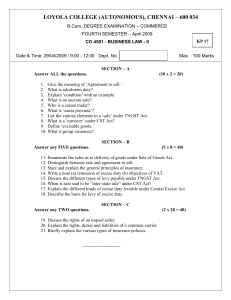
![-----Original Message----- From: DCB [ ]](http://s2.studylib.net/store/data/015588025_1-73e3da362d1566ceb237ab045e4998c8-300x300.png)
